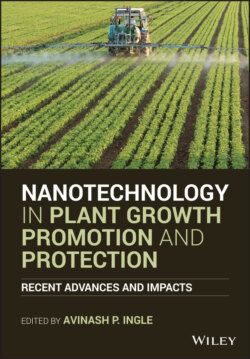Читать книгу Nanotechnology in Plant Growth Promotion and Protection - Группа авторов - Страница 12
1.1 Introduction
ОглавлениеNanotechnology is a modern and creative science which involves the designing, manipulation, and use of nanoscale materials (Ali et al. 2014; Agrahari and Dubey 2020). The term “nano” is a Greek word which actually means “dwarf,” and when it is used to describe materials, it is supposed to have at least one dimension of 100 nm or less. Today, nanotechnology has entered in every aspect of day to day life (Zulfiqar et al. 2019). In medicine, nanotechnology has made breakthrough improvements as a means of smart drug delivery systems and many other applications. When it comes to agriculture field, research is still under way to discover the applications of nanomaterials to improve plant growth and control plant diseases (Ali et al. 2014; Zulfiqar et al. 2019; Agrahari and Dubey 2020).
Nanomaterials or nanoparticles can be manufactured using different ways, such as top‐down and bottom‐up approach. The production of nanomaterials through top‐down approach involves the breaking down of bulk materials into nanosized structures or particles. The disadvantage of this method is low control on the size of nanoparticles and a greater amount of impurities. On the contrary, bottom‐up approach of nanoparticles synthesis involves building up of a material from the bottom, i.e. atom‐by‐atom, molecule‐by‐molecule, or cluster‐by‐cluster. It is usually a chemically controlled synthesis process, so this method has better control on particle size and also reduces impurities. In addition, nanoparticles can be biologically manufactured which is also called as biomanufacturing method. Different biological systems such as plants, fungi, and bacteria can be used for this purpose. The advantage of this method is the greater control over the toxicity and size of the particle (Heikal and Abdel‐Aziz 2020). The global population is rapidly increasing and is supposed to reach 9.6 billion by 2050 leading to many concerns (Zhang et al. 2015). The major problem will be how to provide food to such growing mass population (Zulfiqar et al. 2019). On the one hand, concerns related to soil fertility are getting worse year after year and the development of urban activities continuously decreasing the cultivated areas. On the other hand, problems related to plant pathogens and their control are also major issues in current scenario (Chhipa 2017). Therefore, question arises that how to produce more food when there are less cultivated lands and nonfertile soils? One of the recent approaches proposed by scientists all over the world is the introduction of nanotechnology in agriculture to solve these problems. The introduction of nanotechnology to agriculture may provide solutions to improve plant growth through the applications of various nano‐based agrochemicals such as nanofertilizers, nanoherbicides, and nanoantimicrobials. In addition, utilization of smart Nanodevices like nanosensors can also help in the detection of pathogens and heavy metals in soil. Thus, nanotechnology converted conventional farming into precision farming (Raliya et al. 2018).
Different nanoformulations like nanofertilizers composed of either macronutrients or micronutrients have been tested in many research works. Some studies showed positive effects on growth and productivity of tested plants and some showed negative impacts especially when used in higher concentrations. Considering these facts, the present chapter is focused on detail review of all such studies. The use of nanotechnology in the management of plant diseases showed promising results having significant impacts on different plant pathogens such as insects, bacteria, fungi, or even viruses. Like every new technology, nanotechnology also has its merits and demerits. The concerns of the use of nanotechnology in agriculture arise from toxicity issues, and their hazardous effects to human health and environment are also discussed in this chapter.
